|
San Diego City and County Historic Designations
By Ann Jarmusch
November/December 2022
At the September 2022 meeting of the City of San Diego Historical Resources Board, members designated a rare Pueblo Revival style bungalow court, a 1923 beach cottage, and a Streamline Moderne building, as well as a Kumeyaay archaeological site in La Jolla. The board also indicated their strong support for designating the 1973 La Jolla home of the late prominent landscape architect Joseph Yamada and his late wife and civic leader, Elizabeth Yamada. The HRB asked the applicant and staff to take 60 days to identify and map more landscape elements planted or designed by the Yamadas between 1973 and their deaths in 2020.
Staff announced that an associate planner and a junior planner have joined the Historic Preservation unit, and an SDSU senior is serving as a management intern.
The board designated these four resources:
|
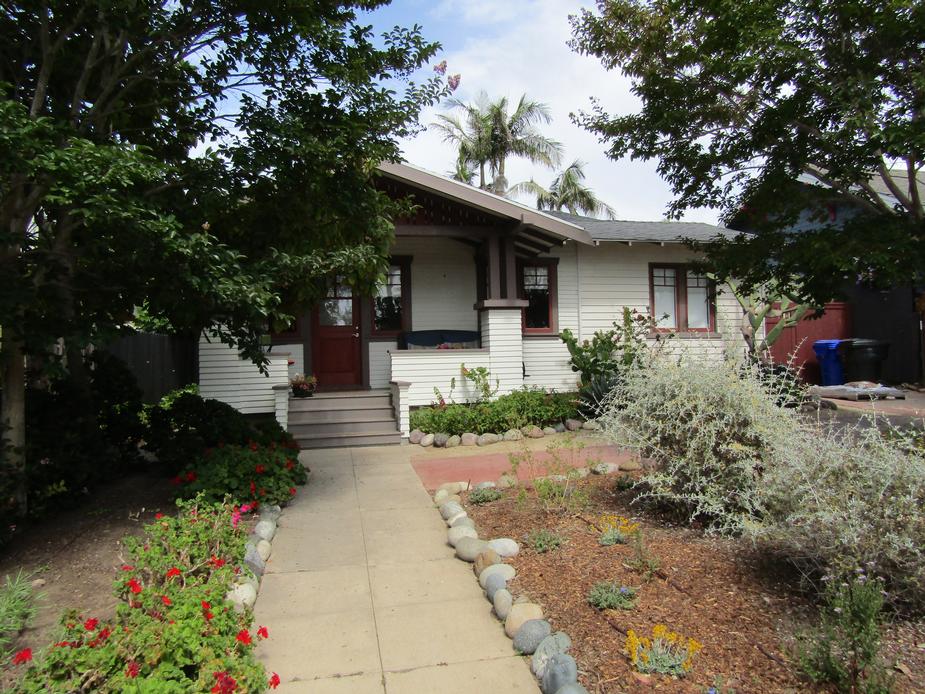 7425 Fay Avenue, La Jolla, is named the Arklow Cottage, with a period of significance of 1923. The Arts and Crafts beach cottage is designated under HRB Criterion A, as a special element of La Jolla’s historical, cultural, social, economic, aesthetic, and architectural development. Once a commonplace type of La Jolla housing, this beach cottage is one of a rapidly dwindling number of historic examples. The single-story, wood-framed home is thought to have been built from a Pacific Ready-Cut kit. Like other local beach cottages, it has a low-pitched gabled roof with wide overhanging eaves and exposed roof rafters, and square columns supporting the partial width front porch. The owners plan to work with the HRB to replace the central front door with one that matches a c. 1924 photograph showing the original door. Fenestration includes multi-light wood casement windows. The designation excludes the rear guest house, 1940s side addition, and 2018 rear addition. 7425 Fay Avenue, La Jolla, is named the Arklow Cottage, with a period of significance of 1923. The Arts and Crafts beach cottage is designated under HRB Criterion A, as a special element of La Jolla’s historical, cultural, social, economic, aesthetic, and architectural development. Once a commonplace type of La Jolla housing, this beach cottage is one of a rapidly dwindling number of historic examples. The single-story, wood-framed home is thought to have been built from a Pacific Ready-Cut kit. Like other local beach cottages, it has a low-pitched gabled roof with wide overhanging eaves and exposed roof rafters, and square columns supporting the partial width front porch. The owners plan to work with the HRB to replace the central front door with one that matches a c. 1924 photograph showing the original door. Fenestration includes multi-light wood casement windows. The designation excludes the rear guest house, 1940s side addition, and 2018 rear addition.
|
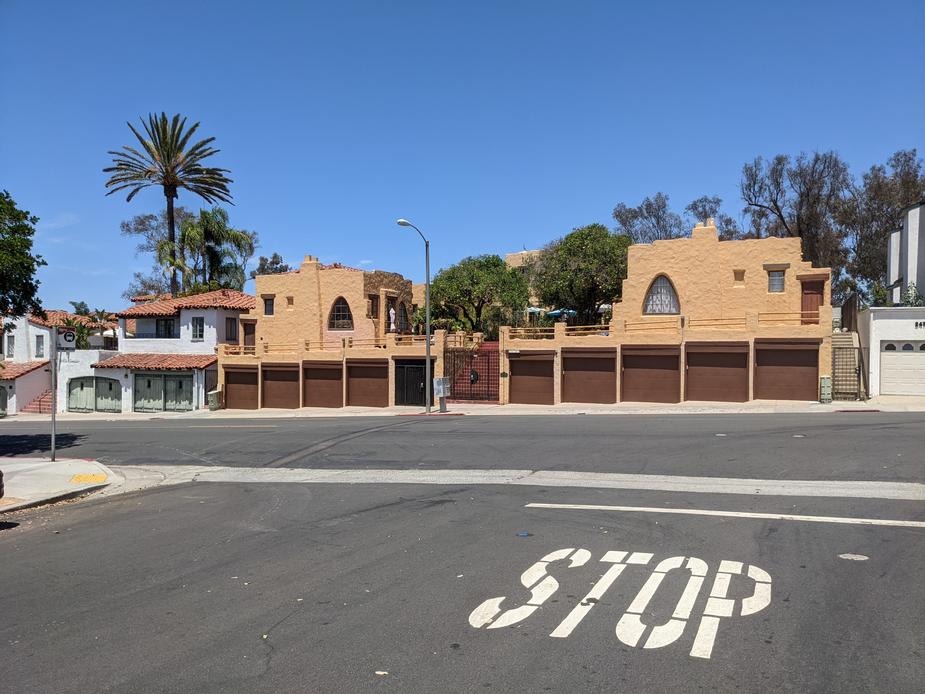 2454-2474 Adams Avenue in University Heights is the site of El Cantorral Court (1928), a rare remaining San Diego example of a Pueblo Revival style building. This popular, neighborhood icon is designated under Criterion A for the city’s development: Bungalow courts were a new type of multi-family housing constructed along transit lines to address San Diego’s early 20th-century population boom and they are unique to southern California. Its Pueblo Revival style architecture meets Criterion C, with an asymmetrical arrangement of units around a U-shaped central courtyard, flat roofs with espadaña parapets; rusticated wooden doors and gates, adobe-like textured stucco over wood-frame construction, battered stucco chimney, and parabolic arched windows and casement windows. It is also recognized under Criterion D, for exemplary design and craftsmanship by Glen Funcheon, who is an HRB proposed master builder. The designation excludes the 1954 laundry room. 2454-2474 Adams Avenue in University Heights is the site of El Cantorral Court (1928), a rare remaining San Diego example of a Pueblo Revival style building. This popular, neighborhood icon is designated under Criterion A for the city’s development: Bungalow courts were a new type of multi-family housing constructed along transit lines to address San Diego’s early 20th-century population boom and they are unique to southern California. Its Pueblo Revival style architecture meets Criterion C, with an asymmetrical arrangement of units around a U-shaped central courtyard, flat roofs with espadaña parapets; rusticated wooden doors and gates, adobe-like textured stucco over wood-frame construction, battered stucco chimney, and parabolic arched windows and casement windows. It is also recognized under Criterion D, for exemplary design and craftsmanship by Glen Funcheon, who is an HRB proposed master builder. The designation excludes the 1954 laundry room.
|
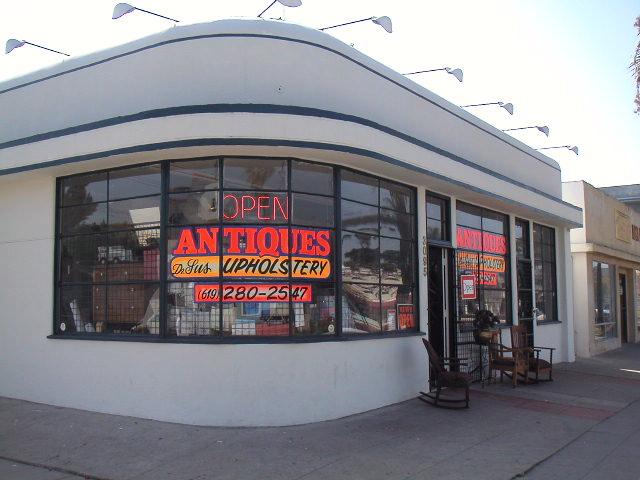 3093-3095 El Cajon Boulevard in North Park is a single-story commercial structure in the Streamline Moderne style. It is named the W.C. and Irene Everett Building for the couple who built it in 1937 for use as Mr. Everett’s real estate office. Examples of what was once a popular style are steadily disappearing from San Diego, making the preservation of this corner building a priority for the board, which designated it under Criterion C for architecture. Its Streamline Moderne elements include a smooth stucco exterior; flat roof with a curved parapet; horizontal overhang inset with “speed lines;” multi-pane wood storefront windows; curved corner windows that fit into curved walls; and an asymmetrical facade. 3093-3095 El Cajon Boulevard in North Park is a single-story commercial structure in the Streamline Moderne style. It is named the W.C. and Irene Everett Building for the couple who built it in 1937 for use as Mr. Everett’s real estate office. Examples of what was once a popular style are steadily disappearing from San Diego, making the preservation of this corner building a priority for the board, which designated it under Criterion C for architecture. Its Streamline Moderne elements include a smooth stucco exterior; flat roof with a curved parapet; horizontal overhang inset with “speed lines;” multi-pane wood storefront windows; curved corner windows that fit into curved walls; and an asymmetrical facade.
|
The Mut kula xuy/Mut lah hoya Site #11, or “place of many caves,” at an unidentified location in La Jolla, is designated under Criterion A, for special archaeological, cultural, and social development of the Kumeyaay tribes of San Diego. A limited subsurface investigation found cultural material and human remains linked to the prehistoric village complex referred to as the Spindrift Archaeological District. The designation applies to the site only and excludes any structures currently on the premises. |
At the October 2022 HRB meeting, staff announced that people may now electronically submit their forms nominating an individual historic property in San Diego for designation, then track the nomination’s progress online as city staff and the HRB evaluate it. . The application can be found on the Individual Historial Resource Nomination page.
Board members seemed to wrestle more than usual with complexities affecting the properties before them. After four hours, they had approved an unusual array of actions: They rescinded the designation of a contributor to the Sherman Heights Historic District; giving their "permission" to demolish, with mitigation measures, an LGBTQ landmark; approved the designation of a 1932 Spanish Colonial Revival style home after an intense discussion about its replacement windows; and agreed to a living architect-developer’s bid to designate his mixed-use building that is only 12 years old.
In all, the HRB designated six resources and approved the Historic Preservation Component of the Mira Mesa Community Plan Update. Except for 750 W. Fir Street, the new landmarks are all single-family homes:
|
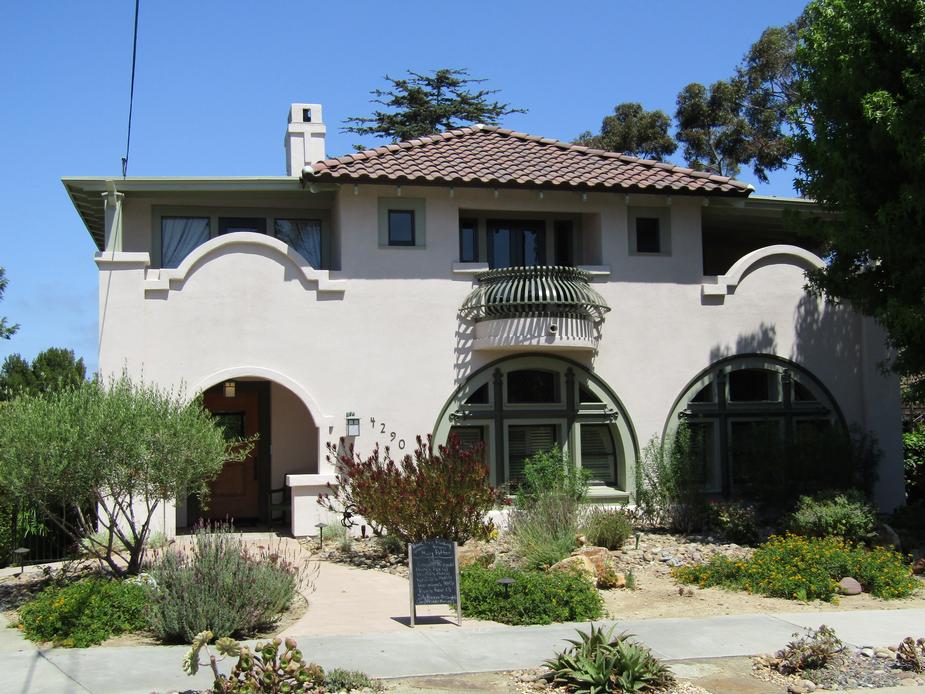 4290 Sierra Vista in Mission Hills - This two-story, 1911 Mission Revival style home is the Arthur and Bertha Cordtz Spec House #1. Designated under Criterion C for an excellent representation of the style, features include an asymmetrical facade, stucco cladding, arched focal windows, an arched entry porch, medium-pitch hipped and flat roof forms with curvilinear parapet, a red S-shaped cement tile roof, and open eaves with decorative cut rafters. The designation excludes the 2015 detached garage and the 1996 and1986 additions. 4290 Sierra Vista in Mission Hills - This two-story, 1911 Mission Revival style home is the Arthur and Bertha Cordtz Spec House #1. Designated under Criterion C for an excellent representation of the style, features include an asymmetrical facade, stucco cladding, arched focal windows, an arched entry porch, medium-pitch hipped and flat roof forms with curvilinear parapet, a red S-shaped cement tile roof, and open eaves with decorative cut rafters. The designation excludes the 2015 detached garage and the 1996 and1986 additions.
|
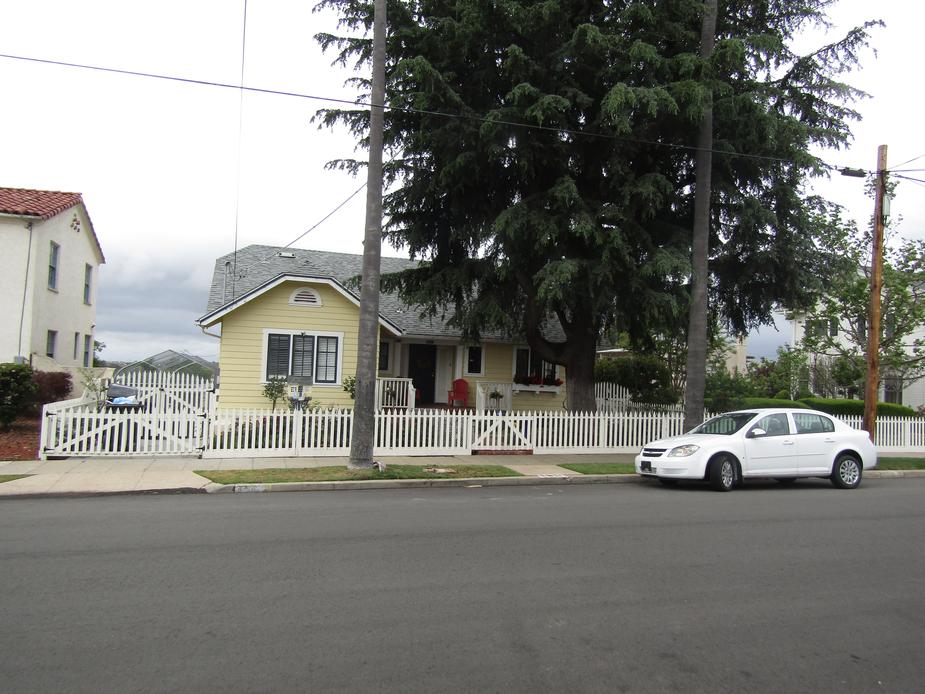 1120 Hunter Street in Mission Hills, is the Walter and Margaret Trepte House #2, with a period of significance of 1922-23. Designated under Criterion C, it embodies the distinctive, character-defining features of the Craftsman style with Colonial Revival influences. The designation excludes the post-2015 front porch balustrade, the 1992 detached garage, and the 1977-2020 attached rear additions/rear deck. 1120 Hunter Street in Mission Hills, is the Walter and Margaret Trepte House #2, with a period of significance of 1922-23. Designated under Criterion C, it embodies the distinctive, character-defining features of the Craftsman style with Colonial Revival influences. The designation excludes the post-2015 front porch balustrade, the 1992 detached garage, and the 1977-2020 attached rear additions/rear deck.
|
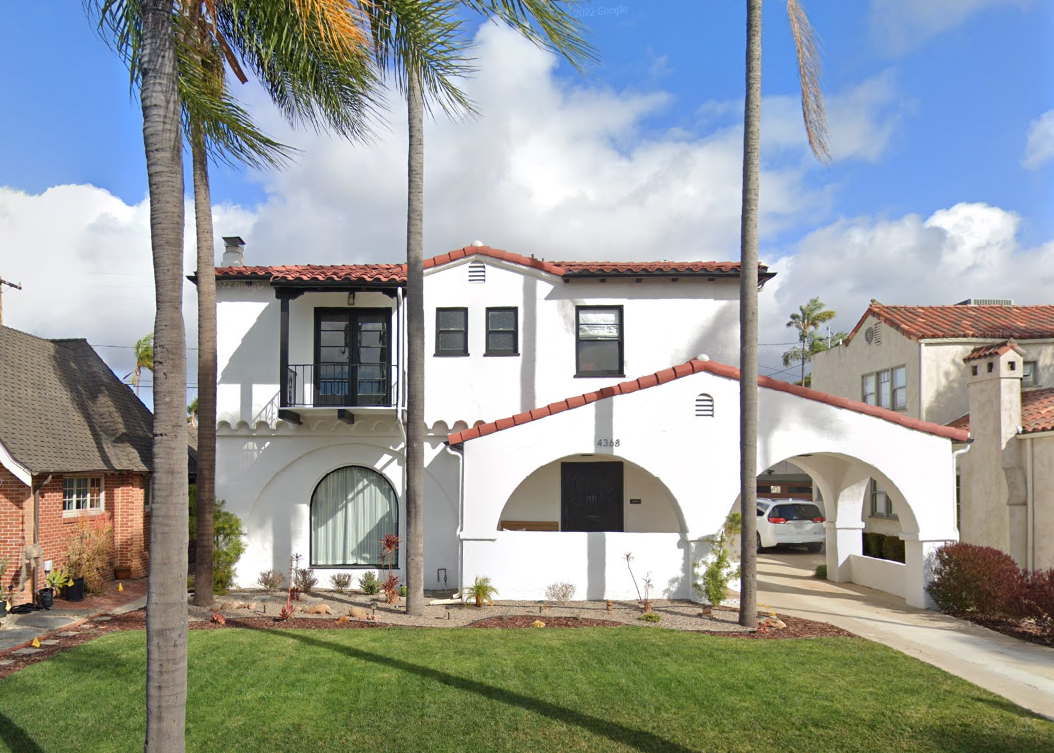 4368 Adams Avenue in the Kensington-Talmadge community, was built in 1929 as the Martin and Norma Brauer Spec House #1. Its Spanish Colonial Revival features meet Criterion C: an asymmetrical facade, stucco exterior, hipped roof with red tiles and little eave overhang, exposed rafter tails, arched porte cochere, stucco chimney, arched focal window, balcony with metal railing, and double hung wood windows. The designation excludes the 1963 rear breakfast nook addition.Courtesy Google Street View 4368 Adams Avenue in the Kensington-Talmadge community, was built in 1929 as the Martin and Norma Brauer Spec House #1. Its Spanish Colonial Revival features meet Criterion C: an asymmetrical facade, stucco exterior, hipped roof with red tiles and little eave overhang, exposed rafter tails, arched porte cochere, stucco chimney, arched focal window, balcony with metal railing, and double hung wood windows. The designation excludes the 1963 rear breakfast nook addition.Courtesy Google Street View
|
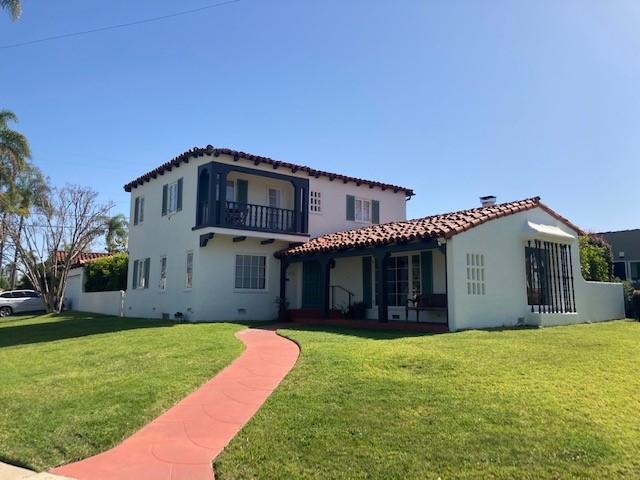 4865 Canterbury Drive in Kensington, is a 1932 Spanish Eclectic style home designated for its architecture under Criterion C. The stucco-clad house has a hipped roof on the two-story section, and a shed and gabled roof on the one-story front wing. The roofs all feature Mission clay tiles, and decorative-cut rafters tails are present. The original side-facing detached garage behind the residence features a hipped roof and stucco siding. Based on historic photographs and visits to the house, the board discussed the typically varied window styles and replacement windows. Because the owner had completed significant restoration work and the window openings, if not the windows, remain original, the HRB designated the house as a good example of the style. Bruce Coons, SOHO’s executive director, advocated designation. He said the corner house is a prominent neighborhood anchor and that he agreed with the owner’s rehabilitation of windows and doors. Furthermore, he noted, if and when new information is received, any inaccuracies can be corrected at that time. The completed work adheres to a strong preservation principle: All of it is reversible. 4865 Canterbury Drive in Kensington, is a 1932 Spanish Eclectic style home designated for its architecture under Criterion C. The stucco-clad house has a hipped roof on the two-story section, and a shed and gabled roof on the one-story front wing. The roofs all feature Mission clay tiles, and decorative-cut rafters tails are present. The original side-facing detached garage behind the residence features a hipped roof and stucco siding. Based on historic photographs and visits to the house, the board discussed the typically varied window styles and replacement windows. Because the owner had completed significant restoration work and the window openings, if not the windows, remain original, the HRB designated the house as a good example of the style. Bruce Coons, SOHO’s executive director, advocated designation. He said the corner house is a prominent neighborhood anchor and that he agreed with the owner’s rehabilitation of windows and doors. Furthermore, he noted, if and when new information is received, any inaccuracies can be corrected at that time. The completed work adheres to a strong preservation principle: All of it is reversible.
|
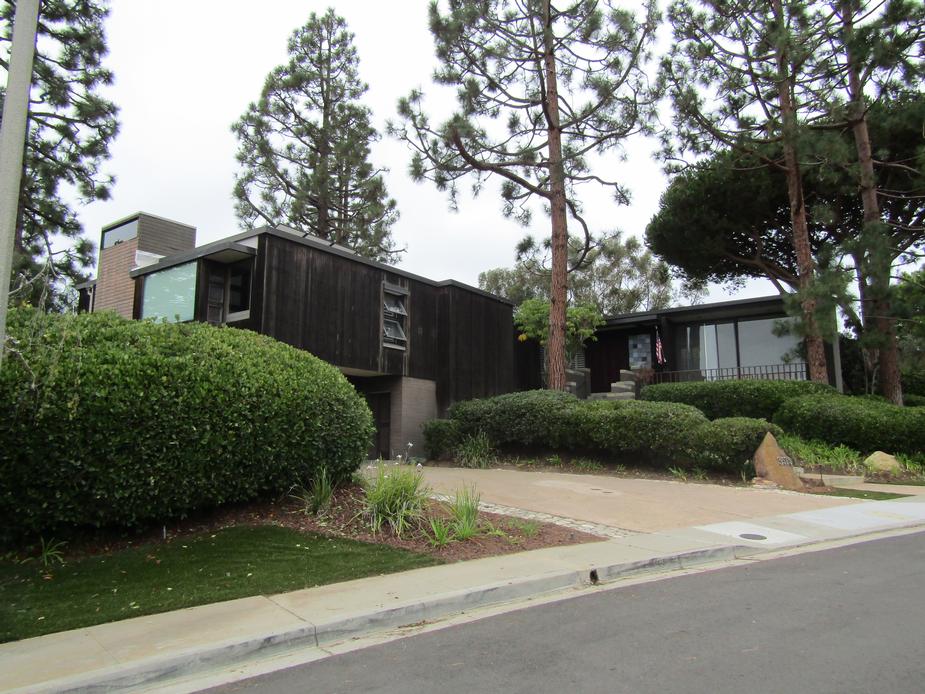 3575 Via Flores in the Wooded Area of Point Loma, is redwood and glass Contemporary style, split-level home with Post and Beam influences. Built in 1968, the two-story structure is designated under Criterion C. Character-defining features include a flat roof form with deep overhangs at some elevations; floor-to-ceiling windows and sliding glass doors; strong interior-exterior connections; vertical redwood siding; a broad brick chimney; recessed entry; and an attached garage. The designation excludes the 1986 rear master bedroom addition. 3575 Via Flores in the Wooded Area of Point Loma, is redwood and glass Contemporary style, split-level home with Post and Beam influences. Built in 1968, the two-story structure is designated under Criterion C. Character-defining features include a flat roof form with deep overhangs at some elevations; floor-to-ceiling windows and sliding glass doors; strong interior-exterior connections; vertical redwood siding; a broad brick chimney; recessed entry; and an attached garage. The designation excludes the 1986 rear master bedroom addition.
|
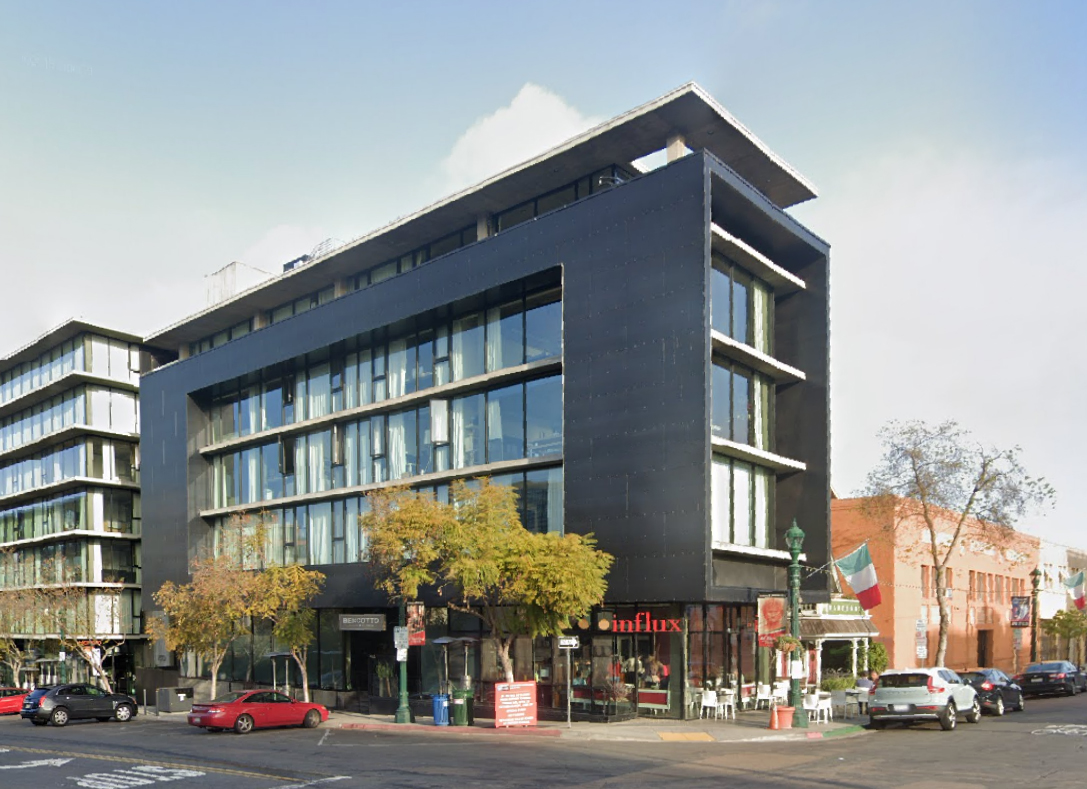 750 W. Fir Street, called The Q, in Little Italy is a Contemporary style, mixed-used building constructed of board-formed concrete, glass, and steel in 2010. It incorporates a designated Victorian Eclectic cottage (the A.W. Pray Rental, HRB #277) moved here for this project. The seven-story Q is designated under Criterion D as the work of Jonathan Segal, a San Diego master architect and master builder. Several well-respected local architects vouched for the design as a pivotal breakthrough—the first residential concrete building to exceed the limitations of wood-framed buildings in height and window size, and said it is being widely copied. The 2010 year built was less of an issue than in the past, since the board named Segal a master architect and master builder in 2021 and has designated two of his other recent buildings in 2021 and 2022.Courtesy Google Street View 750 W. Fir Street, called The Q, in Little Italy is a Contemporary style, mixed-used building constructed of board-formed concrete, glass, and steel in 2010. It incorporates a designated Victorian Eclectic cottage (the A.W. Pray Rental, HRB #277) moved here for this project. The seven-story Q is designated under Criterion D as the work of Jonathan Segal, a San Diego master architect and master builder. Several well-respected local architects vouched for the design as a pivotal breakthrough—the first residential concrete building to exceed the limitations of wood-framed buildings in height and window size, and said it is being widely copied. The 2010 year built was less of an issue than in the past, since the board named Segal a master architect and master builder in 2021 and has designated two of his other recent buildings in 2021 and 2022.Courtesy Google Street View
|
Demolition and Rescission
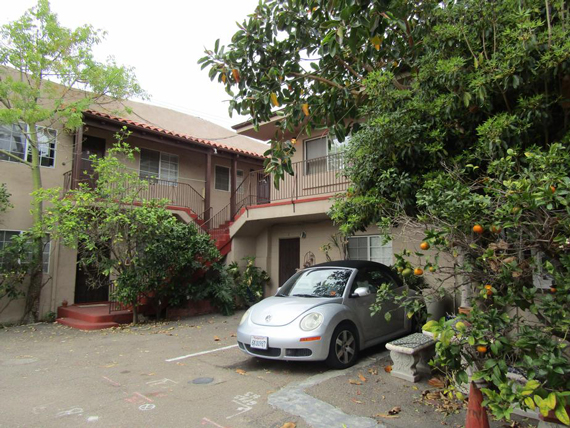 The HRB agreed to the demolition, with mitigation measures, of an LGBTQ landmark in Hillcrest that the board designated only a few months ago, in April 2022. The LGBTQ Community/Albert Bell Building at 3780-3786 Fifth Avenue was added to the historic register for its history of serving the LGBTQ community (Criterion A) and its association with the community leader Albert Bell (Criterion B). Its demolition is especially unwelcome as it is one of only two designated buildings associated with San Diego LGBTQ events and people. The HRB agreed to the demolition, with mitigation measures, of an LGBTQ landmark in Hillcrest that the board designated only a few months ago, in April 2022. The LGBTQ Community/Albert Bell Building at 3780-3786 Fifth Avenue was added to the historic register for its history of serving the LGBTQ community (Criterion A) and its association with the community leader Albert Bell (Criterion B). Its demolition is especially unwelcome as it is one of only two designated buildings associated with San Diego LGBTQ events and people.
SOHO’s Bruce Coons emphasized in person and in a letter to the HRB that the board’s concurrence with the Development Services Department to proceed with demolition must not be used as a precedent for future such sites. The demolition and the mitigation measures the developer proposed are not adequate mitigation for the loss of a historic site under CEQUA. “While we are disappointed that the historic building was not incorporated into the proposed project, the developer has worked diligently with the community and SOHO, and has proposed and agreed to several mitigations and other measures to help perpetuate the history of the site. Chuck Kaminski drafted and SOHO supported that new language for mitigation measures be memorialized as part of the conditions for HRB approval, and the developer agreed. The additions are: Mitigation 1 requires the existing building be documented in the Historical American Building Survey (HABS); add inclusion of the drone flyover footage and a 3D walk through of the building and courtyard. This same footage needs to be incorporated into a longer video being created under Mitigation 2’s interpretive display and/or into the oral history (Mitigation 3). For the interpretive display, the developer will create a QR barcode and link it to an online website in perpetuity, in case the property changes hands. The QR code will also enable viewing of a 2- to 3- minute video excerpted from the longer video the developer will create about the site and its history.
|
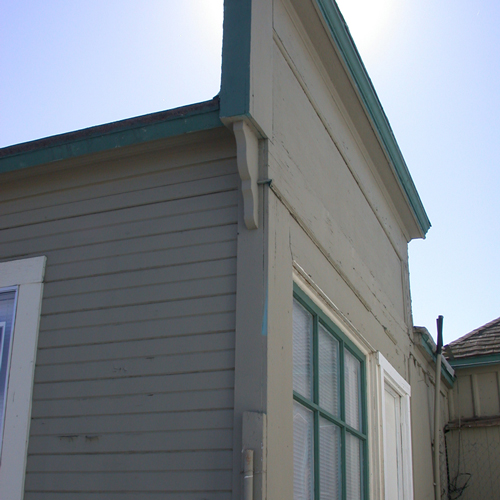 The board also made a very rare decision to rescind a previous board’s 1987 designation of a 1904 Victorian Folk cottage, at 543-547 25th Street, as a Sherman Heights Historic District contributor. The building’s deteriorated condition was a factor in their thinking. SOHO’s Bruce Coons argued for upholding the designation because the former house is a rare remaining worker’s cottage with a false front that he had specifically photographed years ago. He added that a “contributor” to a historic district is just that, and is not required to be individually eligible for designation. Finally, he said historic districts should include buildings that represent the full range of incomes of former residents. Sherman Heights can claim the grand Villa Montezuma and this modest worker’s cottage. Photo by Bruce Coons The board also made a very rare decision to rescind a previous board’s 1987 designation of a 1904 Victorian Folk cottage, at 543-547 25th Street, as a Sherman Heights Historic District contributor. The building’s deteriorated condition was a factor in their thinking. SOHO’s Bruce Coons argued for upholding the designation because the former house is a rare remaining worker’s cottage with a false front that he had specifically photographed years ago. He added that a “contributor” to a historic district is just that, and is not required to be individually eligible for designation. Finally, he said historic districts should include buildings that represent the full range of incomes of former residents. Sherman Heights can claim the grand Villa Montezuma and this modest worker’s cottage. Photo by Bruce Coons
|
City of Coronado Designations
The City of Coronado Historic Resources Commission designated two resources at its October 19, 2022 meeting. |
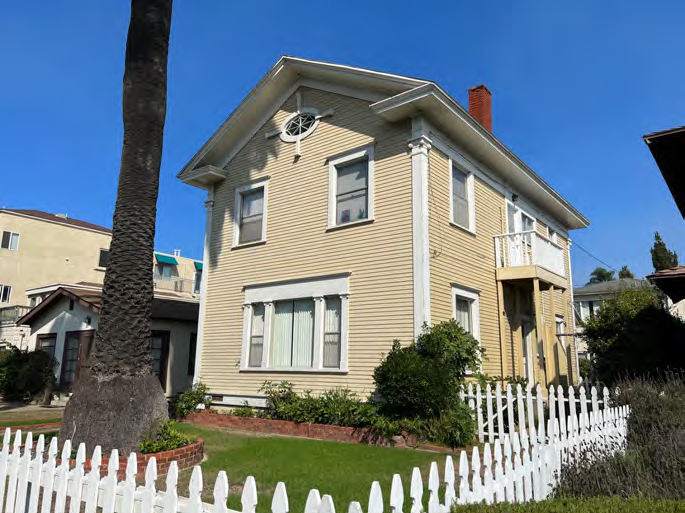 741-45 Orange Avenue is a two-story, multi-unit dwelling constructed in 1896 in the Colonial Revival style with Greek Revival elements. Cited as early as 1897 as an example of Coronado’s development into a residential community, it was also one of only a handful of buildings represented on the 1906 Sanborn Map. These factors qualify the dwelling for designation under Criterion A, as a contributor to the city’s economic and aesthetic history. It is also designated under Criterion C for its architecture. A separate 1954 structure at the rear of the lot is not included in the designation. Courtesy City of Coronado 741-45 Orange Avenue is a two-story, multi-unit dwelling constructed in 1896 in the Colonial Revival style with Greek Revival elements. Cited as early as 1897 as an example of Coronado’s development into a residential community, it was also one of only a handful of buildings represented on the 1906 Sanborn Map. These factors qualify the dwelling for designation under Criterion A, as a contributor to the city’s economic and aesthetic history. It is also designated under Criterion C for its architecture. A separate 1954 structure at the rear of the lot is not included in the designation. Courtesy City of Coronado
|
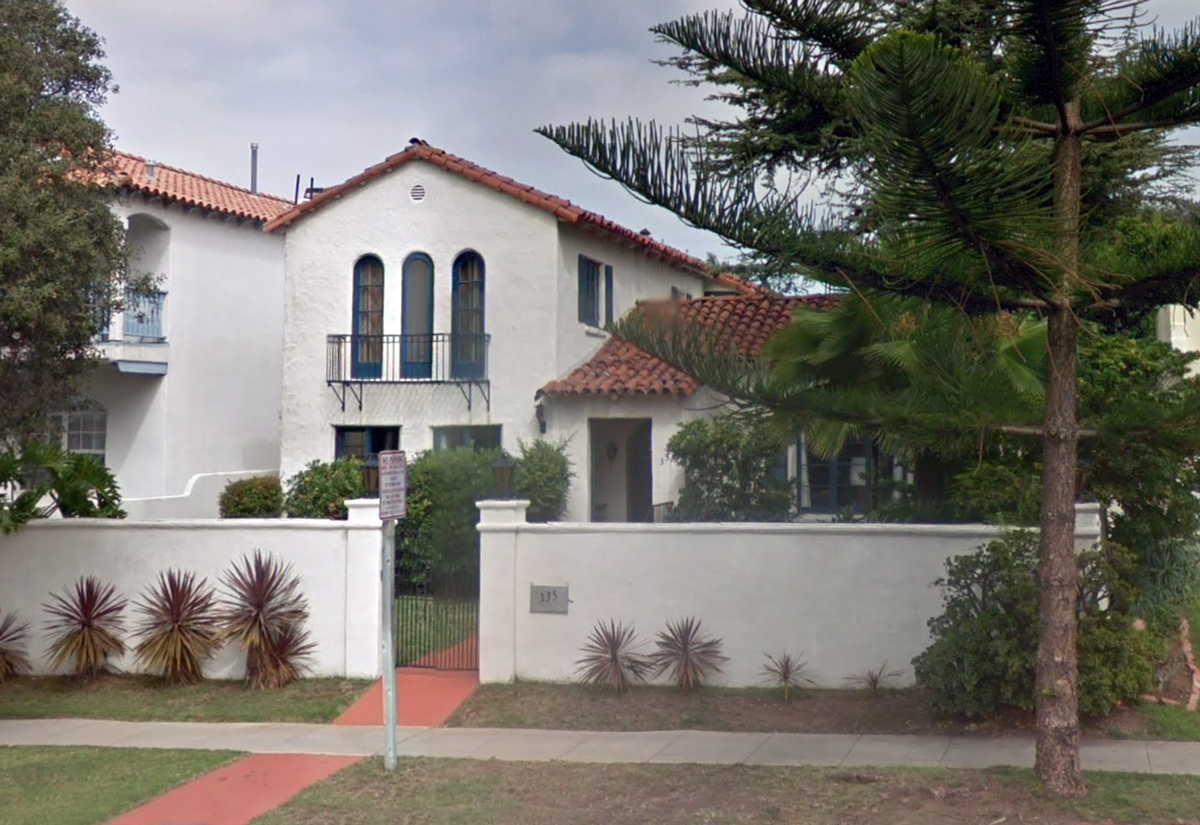 335 Alameda Boulevard is a Spanish Colonial Revival style dwelling and garage built in 1926. As a good, relatively unaltered example of the style, the two-story house qualifies for designation under Criterion C. It also meets Criterion D as a notable work of Oscar W. Dorman, a prolific Coronado builder who mastered various period revival styles. Several of Dorman’s buildings have been designated as historic resources. This one continues to represent Dorman’s original work, as it is minimally modified and retains architectural and material integrity from 1926. Courtesy Google Street View 335 Alameda Boulevard is a Spanish Colonial Revival style dwelling and garage built in 1926. As a good, relatively unaltered example of the style, the two-story house qualifies for designation under Criterion C. It also meets Criterion D as a notable work of Oscar W. Dorman, a prolific Coronado builder who mastered various period revival styles. Several of Dorman’s buildings have been designated as historic resources. This one continues to represent Dorman’s original work, as it is minimally modified and retains architectural and material integrity from 1926. Courtesy Google Street View
|
All photos are from the California Historical Resources Inventory Database (CHRID), except where noted otherwise. The above designations were reviewed and approved by the City of San Diego Historical Resources Board (HRB), the County of San Diego Historic Site Board (HSB), or the Coronado Historic Resources Commission.
|
2025
2024
2023
2022
2021
2020
2019
2018
2017
2016
2015
|
















